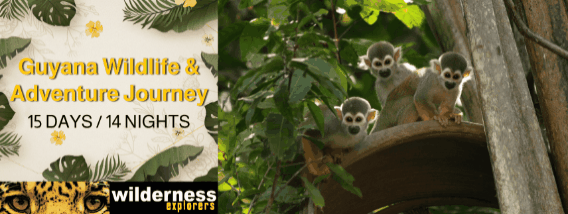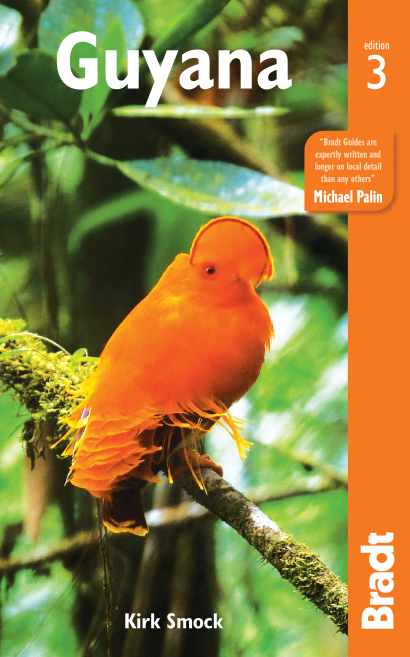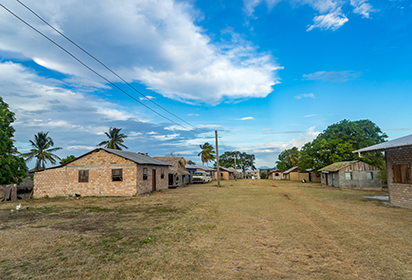English-speaking, jungle-covered and stuffed full of wildlife and birds, Guyana won’t be a South American secret for long.
Kirk Smock, author of Guyana: the Bradt Guide
Guyana remains one of South America’s real secrets, hidden between its bigger and better-known neighbours. This small country – home to 2,000 animal species – has everything you need for a wildlife adventure: unexplored equatorial rainforest, the dramatic Kanuku Mountains, sea turtles on pristine beaches, the ferocious Kaieteur Waterfall and the beautifully moody Essequibo River.
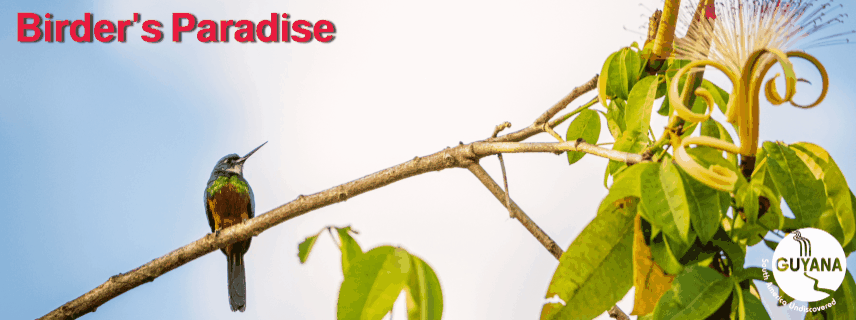
Guyana leads you into a million-acre rainforest reserve and hurriedly past the world’s largest alligators; through 11,000 years of history and culture to colonial Georgetown; into welcoming Amerindian communities in the Rupununi savannas; and to hammocks and lodges where you can relax among nature’s riches.
For more information, check out our guide to Guyana:
Guyana is on our list of 2023 Exceptional Trips! Read the full list here.
Food and drink in Guyana
A range of cultures, including East Indian, African, Amerindian, Brazilian and Chinese, influence Guyanese cuisine. Perhaps the best thing about Guyanese cuisine is that it’s almost always made with fresh ingredients from the farm, tree, river or sea. As should be expected, Guyanese cuisine is more Caribbean than Latin. Staple dishes include various curries, often eaten with roti, a fried flatbread, and dhal; cookup rice (rice cooked with coconut milk and whatever is on hand: peas, okra, beans, plantains) that is often served with fried chicken or fish; fried rice; Caribbeanstyle chow mein (stir-fried soft noodles often topped with fried chicken); and all meals are accompanied with excellent fiery pepper sauces. Mango achar also makes wonderful complement for most meals. Speciality dishes include pepperpot, an Amerindian stew made with meat, peppers and cassareep, an extract of cassava that has long been valued for its preservative qualities, allowing pepperpot to last indefinitely (it’s widely available to buy in Guyana); and metemgie, a thick coconut-based soup filled with dumplings, fish or chicken and a host of provisions including eddoes, yams, cassava and plantains. Garlic pork, which is a form of pickled pork, is a Portuguese dish traditionally served for Christmas. Breakfasts often mirror lunch, with many eating hearty curries and rotis. Bakes, which are most often fried pieces of dough, are often served with salt fish; pepperpot is also popular for breakfast.
Homemade breads are popular in the interior where Amerindian populations have perfected the craft over the years. Favourite pastries with a British influence include cheese flaps, pine (pineapple) tart and solara, a cake rolled around a red coconut filling. The densely-moist and savoury-sweet cassava pone is also a popular dessert featuring coconut. Adventurous eaters can also sample a range of wild meats while in Guyana; they are commonly found on menus in many smaller villages. Labba, agouti, peccary and paca are just a few.
Sampling
Any eating tour should start with street snacks. Fried plantain chips topped with mango sour (boiled green mangos and peppers) provide a good salty backdrop to a superb selection of fresh fruit; the pineapples are not to be missed. A good lunch option (besides chicken and rice) is a bowl of curry eaten with roti. Curried ingredients range from mutton to shrimp, pumpkin to eggplant, and all are worth sampling. Come dinner, sample the seafood, which is plentiful and cheap. Usually the freshest options are snapper, trout, and prawns. Have the prawns marinated in garlic and butter, the trout served with a tropical salsa or the snapper lightly fried. And don’t be afraid to accompany any meal with the always present homemade and quite hot pepper sauces.
Restaurants
In Georgetown
There are a handful of good restaurants that cater to the well-established expat scene, well-off Guyanese and the occasional tourists. Most have varied menus of different meats (chicken, beef, pork) and seafood (prawns, fish) cooked in a variety of ways. Meals in Georgetown’s nicer restaurants cost between US$10 and 25, for food only. By eating at small establishments favoured by locals you can get very large portions for around US$2–4. The only thing lacking is a wide variety and ambience (which can be relative).
Outside of Georgetown
Options grow slimmer here. Most restaurants and smaller places that serve food are geared towards local tastes. Variety is limited, but the portions are often huge, the food good and the prices low (US$3–5). Expect variable service wherever you eat. Even the nicest restaurants can sometimes take more than an hour to bring the wrong plate to your table. The mystery of the service you’ll receive is part of the experience.
Cafés and bars
In Guyana most restaurants also double as a place to have a drink. For a quieter atmosphere it’s best to seek out a hotel bar or higher-class restaurant. For a bit more of a local experience, often accompanied by blaring music, visit a rum shop. Rum shops are the cheapest options and it’s where most head to do some serious drinking. Prices for drinks vary according to the establishment you are at. The cheapest option is to drink local beer (Banks) and rum (El Dorado); the beer is good and the rum is world-renowned. Local bars will charge around US$1.50 for a local bottle of beer, but this can be doubled at restaurants. Nicer restaurants will have a stocked bar full of local and imported spirits, a few red and white wines and a limited selection of local and imported beer. Most international brands of sodas, soft drinks and other such sugar or fizz-laden beverages are widely available.
Self-catering
Preparing your own meals is not a problem in much of the coastal areas, provided you have cooking facilities. Georgetown and most other towns have grocery stores stocked with local and imported products. There are also very good markets throughout the country where you can buy fresh fruits, vegetables, meats and fish. Buying local food is much cheaper than purchasing imported goods. In smaller interior locations it can be harder to come by fresh vegetables but most shops stock basic tinned foods.
Health and safety in Guyana
Health
People new to exotic travel often worry about tropical diseases, but it is accidents that are most likely to carry you off. Road accidents are common in many parts of Guyana so be aware and do what you can to reduce risks: try to travel during daylight hours, always wear a seatbelt and refuse to be driven by anyone who has been drinking. Listen to local advice about areas where violent crime is common too.
Make sure all your immunisations are up to date. A yellow fever vaccination is advised for health as there is risk of the disease, and immigration officials may require you to show proof of immunisation upon entry if you are entering Guyana from another yellow fever endemic area (a requirement that excludes visitors from North America and Europe). A valid yellow fever vaccination certificate (currently valid for life since July 2016, although there are exceptions so always check) will then be required on entry. If the vaccine is not suitable for you then you would be wise not to travel. Yellow fever is prevalent in parts of Guyana and has around a 50% mortality rate in those who are non-immune to the disease.
It’s also unwise to travel without being up to date on tetanus, polio and diphtheria (now given as an all-in-one vaccine, Revaxis). Immunisation against hepatitis A, typhoid, rabies, hepatitis B, and possibly tuberculosis (TB) may also be recommended.
Despite recent efforts, malaria remains a problem in parts of Guyana. The interior of Guyana is considered to be a sufficient risk for malaria that anti-malarial tablets are advised; Georgetown and the coastal areas are considered very low risk so they are not deemed necessary.
Though advised for everyone, a pre-exposure course of rabies vaccination, involving three doses taken over a minimum of 21 days, is particularly important if you intend to have contact with animals, or are likely to be 24 hours away from medical help. If you have not had this then you may need to evacuate for medical treatment, as local hospitals almost certainly will not have all the necessary treatment.
Anybody travelling away from major centres should carry a personal first aid kit. Contents might include a good drying antiseptic (eg: iodine or potassium permanganate), Band-Aids, suncream, insect repellent, aspirin or paracetamol, antifungal cream (eg: Canesten), an antibiotic to treat severe diarrhoea, antibiotic eye drops, tweezers, condoms or femidoms, a digital thermometer and a needle-and-syringe kit with accompanying letter from a health-care professional.
Bring any drugs or devices relating to known medical conditions with you. That applies both to those who are on medication prior to departure, and those who are, for instance, allergic to bee stings, or are prone to attacks of asthma. Carry a copy of your prescription and a letter from your doctor explaining why you need the medication.
Travellers should take precautions to avoid being bitten by mosquitoes at all times by using insect repellents (at least 30% DEET on exposed skin). As the sun is going down, don long clothes and apply repellent on any exposed flesh. Pack a DEET-based insect repellent (roll-ons or stick are the least messy preparations for travelling). You also need either a permethrin-impregnated bednet or a permethrin spray so that you can ‘treat’ bednets in hotels. Permethrin treatment makes even very tatty nets protective and prevents mosquitoes from biting through the impregnated net when you roll against it; it also deters other biters. Otherwise retire to an air-conditioned room or burn mosquito coils or sleep under a fan. Coils and fans reduce rather than eliminate bites. Travel clinics usually sell a good range of nets, treatment kits and repellents.
Prolonged immobility on long-haul flights can result in deep vein thrombosis (DVT), which can be dangerous if the clot travels to the lungs to cause pulmonary embolus. The risk increases with age, and is higher in obese or pregnant travellers, heavy smokers, those taller than 1.8m or shorter than 1.5m, and anybody with a history of clots, recent major operation or varicose veins surgery, cancer, a stroke or heart disease. If any of these criteria apply, consult a doctor before you travel.
Travel clinics and health information
A full list of current travel clinic websites worldwide is available on www.istm.org. For other journey preparation information, consult www.travelhealthpro.org.uk (UK) or http://wwwnc.cdc.gov/travel/ (US). Information about various medications may be found on www.netdoctor.co.uk/travel. All advice found online should be used in conjunction with expert advice received prior to or during travel. The Bradt website has a Central and South America health section to help travellers prepare for their trip.
Medical facilities in Guyana
The medical facilities in Guyana will almost certainly be limited which is another reason for having appropriate and robust medical insurance. Always contact them sooner rather than later if you are unwell. Also ensure that you take all your prescription medications with you as it is extremely unlikely that they will be available in Guyana.
Safety
When doing initial pre-trip research on Guyana, it would be easy to be turned off by the crime in the country. The media love to sensationalise stories of bandits, pirates and machete-wielding husbands. Crime rates are indeed high in Guyana, but they are mainly concentrated along the coastal areas and foreign tourists are rarely targeted. Keep in mind that most visits to Guyana are trouble-free, and occurrences of crime in the interior are fairly uncommon
Guyana is a developing country with a noticeable disparity of wealth. Guyana is also a major drug transhipment country, with a large amount of cocaine funnelling into the country from Venezuela and being shipped out to other Caribbean countries, the US and Europe. Both are behind many of the crimes that take place in Georgetown and other coastal towns and rarely affect those not involved. In 2016, the US Drug Enforcement Agency (DEA) opened an office in Georgetown to help the Guyanese authorities crack down on drug trafficking; this has already seen some major results.
Petty crimes such as pickpocketing, purse snatching and theft of other goods occur throughout Georgetown and travellers should always remain on the defensive. The best way to avoid crime is by not showcasing any signs of wealth. Don’t travel with valuable jewellery. In Georgetown and other areas along the coast, don’t prominently display cameras, music players or other high-priced electronics. (In fact, in Georgetown, unless you are on an organised tour or with locals, you may want to consider keeping any expensive cameras at the hotel and purchasing postcards.) When going to banks or cambios (businesses that exchange foreign currencies) to change money it’s advisable to always use a reputable taxi company (hailing an unmarked car from the street in front of the bank may not be the best option).
Don’t carry large sums of money around town and it may be a good idea to disperse your notes throughout a few different pockets so that you don’t pull out a large wad of money when paying for something. If you ever find yourself the victim of a robbery, it’s best to hand over whatever is being demanded without resisting. Most injuries that are the result of a robbery occur because of resistance. All crimes should be reported to the local police, but don’t have expectations of your case being solved.
Walking in Georgetown is generally okay during daylight hours, but taxis should be used at night. Most hotels and restaurants have security. Exercise extra caution while walking on Sundays, when the city’s streets are much less populated. When visiting the sea wall it’s recommended to avoid deserted stretches (east of Celina’s Atlantic Resort is best) and to go only when it is most populated with walkers and joggers (roughly 17.00–18.00). The sea wall has been the scene of various crimes in the past so it’s advised to go with at least one other person and avoid the area at dark (except on Sunday night when it becomes a gathering place for the entire town).
In the waters there are also attacks by pirates on fishing vessels. It is very rare for such an occurrence to take place on public speedboats or ferries. Again, if you exercise caution, don’t flaunt any valuables and remain alert and vigilant your time in Guyana will most likely be trouble-free.
Female travellers
In general, the most common problems women travelling in Guyana will encounter are inappropriate comments and verbal harassment. Maintain your composure and do not react to verbal comments or hissing/sucking. Be sensitive to the local dress standards; you may want to dress more conservatively to help avoid unwelcome attention. You may also want to wear a ring to fend off unwanted suitors. Use common sense – don’t walk alone at night and be aware of your surroundings at all times. Stay in well-populated areas, as most acts of robbery or assault take place on lonely streets. Sundays and holidays tend to be particularly quiet, so be careful if walking around Georgetown alone on these days. Look and act confident; walk like you know where you are going – if you display self-assurance, you may ward off some potential danger.
LGBTQ+ travellers
Guyana is, unfortunately, the only country in South America where homosexuality remains illegal. According to the country’s draconian penal code, any male persons committing or attempting to commit an act of ‘gross indecency…shall be guilty of misdemeanour and liable to imprisonment for two years.’ ‘Buggery’ is listed as a felony and can carry penalties from ten years to life in prison. There is no reference to lesbianism in the books, making it technically legal, but not necessarily tolerated.
In 2001, Guyana’s parliament voted to outlaw discrimination based on sexual orientation, but under extreme pressure from religious groups, President Jagdeo refused to assent to the amendment bill. In 2003, parliament was scheduled to again discuss the bill. To garner public support and advocate against homophobia, the Society Against Sexual Orientation Discrimination (SASOD) was formed at this time. Parliament proposed another bill, but the ruling party once again said it would not vote on it. Since 2003, SASOD has continued its advocacy work in Guyana and regularly organises LGBT film festivals, poetry nights and other special events at locations in Georgetown including the Sidewalk Café and Oasis Café. Actual enforcement of, and punishment associated with, the law outlawing homosexuality is extremely rare in Guyana. Gay travellers are unlikely to encounter any problems during a visit to Guyana, but it isn’t recommended to make a point of drawing attention to their sexual orientation. Other than the sporadic events organised by SASOD (who have offices in Georgetown), there is nothing that can be called a gay scene anywhere in the country.
Travellers with a disability
Guyana, as a whole, is relatively inaccessible for people with disabilities. In Georgetown and other coastal towns, pavements are a rarity and potholed road surfaces would prove challenging for those in a wheelchair. Accessibility to public areas is limited. But with patience, people with disabilities can still travel throughout Guyana. In Georgetown, few hotels have lifts (namely Pegasus Guyana and Princess Hotel), but others will have some rooms on the main level; enquire when making your booking or seek assistance from a local tour operator. At interior lodges, few are built to accommodate people with disabilities. Many are elevated off the ground and use steps for access. Some, like Rock View Lodge and Karanambu Lodge, have cabins and rooms that are on ground level. If travelling to the interior, it is recommended to use a local tour operator that is familiar with the infrastructure of each individual lodge so proper arrangements can be made.
For transportation, taxis or private vehicles are recommended. Minibuses are often overcrowded and the drivers are likely to be less patient with riders needing extra time to get in and out of the vehicle. While it won’t always be easy, most people with disabilities will likely be pleasantly surprised by the amount of assistance and help they receive. Getting in and out of small aircraft, aluminium boats, and 4×4 vehicles can be a challenge, but helping hands will always be available to make experiencing Guyana’s interior a possibility.
Travelling with children
Depending on their age, travelling in Guyana with children, particularly in the interior, could be considered challenging. Simply put, child-specific facilities do not exist. This could make travelling with young children difficult. If the child is a bit older, however, and enjoys hiking, boat trips, fishing, 4×4 trips on rough roads and generally being outdoors, Guyana could prove a wonderful experience.
At interior lodges, while there is much to do that revolves around nature, the travel can be arduous and parents may worry about safety precautions not being up to Western standards. Child-size life jackets, for example, would likely be hard to come by and child seats for vehicles are not common (better to bring one). If considering travelling with children in Guyana, parents should review the health section in detail and make sure all necessary precautions and vaccinations are considered.
Travel and visas in Guyana
Visas
Visas are required for all visitors except for nationals of the following countries: Commonwealth countries, Belgium, Denmark, Finland, France, Germany, Greece, Ireland, Italy, Japan, Korea, Luxembourg, the Netherlands, Norway, Portugal, Spain, Sweden and the USA. Visitors from these countries will receive a stamped visa upon entry that is good for up to three months (depending on your length of stay). If you will be staying for more than three months and need to extend or renew your stamp, take your passport to the Ministry of Home Affairs and be prepared to wait. Visitors arriving by air are required to have an onward ticket. If you plan on hiring a car, it is compulsory for overseas visitors to obtain a local driver’s permit issued by the Guyanese Revenue Authorities. Permits are valid for a month and can be obtained at Cheddi Jagan International Office or at the License Revenue Office at Smythe and Princess streets, Werk-en-Rust for approximately US$10 on presentation of a valid international driving licence.
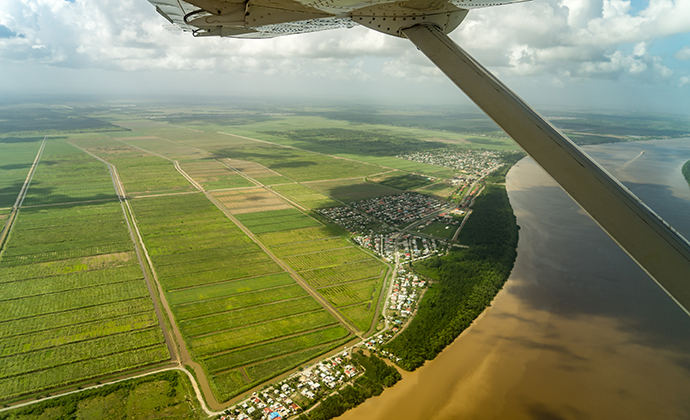
Getting there and away
By air
From Europe
There are no direct flights to Guyana; all flights from Europe are routed through the Caribbean, Suriname or the USA. It’s possible to fly from Europe to a number of the Caribbean islands but all flights to Guyana are eventually routed through Trinidad or Barbados. Options are numerous and many choose to combine a Caribbean stay with their trip to Guyana.
From the USA
There are daily direct (via Trinidad) and from December 2018, American Airlines will have non-stop flights from Miami to Georgetown. It’s also possible to plan your route through the Caribbean from the USA. It is easier to fly to Guyana from the west coast of the United States now that Copa have introduced a handy service from Los Angeles to Georgetown via Panama three times a week.
From Canada
There are direct flights from Toronto to Georgetown, with a stop to pick up and drop off passengers in Trinidad.
From South America
Simply put, outside of Suriname and northern Brazil, travel is difficult to or from other South American countries. As strange as it sounds, barring a long journey of short interior flights and overland buses, the easiest flight plan to/from most South American countries often entails transferring through Trinidad, Barbados or the USA.
From the Caribbean
As mentioned above, most flights to and from Georgetown are routed through Trinidad or Barbados, making the island nations to the north very accessible. Depending on the plane (propeller or jet) flying time is 1 to 2 hours.
Airports
Most international flights leave from and arrive at Cheddi Jagan International Airport, which is located at Timehri, 41km (1 hour) south of Georgetown. The recently renamed Eugene F Correia International Airport, formerly known as Ogle and still often called this by locals, now handles many flights from Suriname and LIAT flights from Barbados, as well as domestic flights into the interior. When going to or from the airport with luggage, visitors are advised to forgo the cheap minibuses and hire a taxi.
By land
From Suriname
The (contested) border between Suriname and Guyana is the Corentyne River. The legal crossing point is in Moleson Creek, where the Canawaima Ferry makes the return trip from Suriname twice per day (leaving Guyana around 10.00 and 12.00). Customs and immigration is handled at the ferry stelling (landing stage); most countries outside of CARICOM countries need a visa to enter Suriname.
In Village 78, near Moleson Creek, there are many speedboats that shuttle passengers across the river, but note that backtracking is illegal, as it entails leaving or entering Guyana without going through the proper immigration requirements. The often overloaded boats are also not the safest passage to or from Suriname.
The ferry stellings on both the Guyana and Suriname sides are well serviced by minibuses and taxis that can provide transportation to the capital cities, Georgetown and Paramaribo. The total travel time between the two cities, including two ferry crossings, is roughly 10 hours. Guyana and Suriname are also exploring options for building a bridge connecting the two countries while drastically cutting the travel time from one capital to another (especially with the new Berbice bridge). Although both sides are in basic agreement to build the bridge, and the EU, China and Brazil have all indicated an interest in the project, there is still a lot to be discussed and funding to be secured before the project can move forward.
From Brazil
The only official border crossing connecting Guyana and Brazil is along the Takatu River, between Bonfim, Brazil and Lethem, Guyana. In the past, the border crossing involved taking a pontoon (vehicles and passengers), small boat or simply walking, swimming or driving during the dry season, but in 2009 the long-delayed Takatu Bridge was officially open.
The bridge, which was funded by Brazil (their first step in what is largely expected to culminate with the paving of the Linden–Lethem road and digging of a deep-sea port in Georgetown) incorporates a unique design that actually transfers drivers to the opposite side of the road while crossing over the Takatu River, which forms the border as in Guyana you drive on the left; in Brazil you drive on the right.
In Guyana, the immigration office is very near the entrance/exit of the bridge and in Bonfim, immigration is located just outside of town. Visits to both are required upon leaving and entering either country, even if it is just for the day.
To travel between Georgetown and Lethem takes roughly 10–15 hours depending on your mode of transport (4×4 vehicle or bus) and the time of year (rainy or dry). From Bonfim there are regular buses to Boa Vista, which provides further access to Manaus and Venezuela.
From Venezuela
Because of the long-standing border dispute between Venezuela and Guyana, there is no legal border crossing between the two countries. The only way to access Venezuela by road, and the route to take when going to or coming from Mount Roraima, is through Boa Vista, Brazil.
By sea
Outside of those arriving on commercial boats, very few enter Guyana by way of sea.
From Venezuela
Just because there are no legal border crossings between Venezuela and Guyana doesn’t mean that you can’t move from one country to the other. From Kumaka, in the northwestern region of Guyana, there are boats that travel to the Venezuelan city of Curiago, which is an official port of entry.
While you can legally enter Venezuela at this point, there are no immigration offices in this area of Guyana, meaning that it’s not possible to enter or leave legally. Unless you are able to hire your own boat in Guyana, this trip isn’t recommended. If you must, choose your boat and captain wisely and be aware that many are also involved in the even riskier illegal ventures of transporting drugs and fuel from Venezuela into Guyana. In 2017, the worsening Venezuelan hunger crisis and three-digit inflation meant very few people were travelling into Venezuela but Venezuelans and Venezuelan-based Guyanese were making their way illegally across the Amacuro River to Guyana to barter for food.
Yachting
In recent years, certain bodies of the local tourism sector have been marketing Guyana as an upcoming yachting destination in the Caribbean. Guyana is being billed as a safe haven for yachters looking to escape the hurricane belt during the hurricane season. Guyana lacks the infrastructure many boaters are used to in the Caribbean, but a semblance of it is offered at the resorts along the Essequibo River, which has been pinpointed as the destination within the destination. To facilitate the expected increase of yachting traffic, new immigration services have been established in Bartica. The yachting boom is yet to arrive.
Cruise ships
Cruise ships are not big business in Guyana. On average, there are maybe three per year that dock at Georgetown. The boats, which are much smaller than the oversized beasts that ply the Caribbean waters to the north, are often part of specialised nature tours or exploratory trips that travel along the coast of South America or the Guianas.
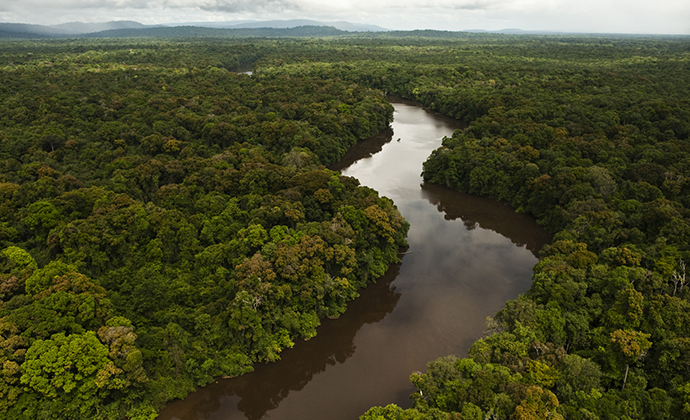
Getting around
Travel in Guyana involves utilising a variety of transportation modes, including walking, taxi, minibuses, buses, 4×4 vehicles, speedboats, ferries, dugout canoes and small aircraft. With paved roads along most of the coastal belt and into Linden, travel is fairly straightforward, but transportation can get progressively more interesting as you move further into the interior. Roads there are unpaved dirt trails and their condition varies wildly throughout the year. In the rainy season many become impassable and rivers and creeks become the preferred ‘roadways’. In many areas of Guyana, rivers are the only way of getting around. Where there are established public boat services, be it on speedboats or ferries, the prices are often affordable. But if you need to hire a boat, prepare to pay. The fastest and most convenient way of getting to interior locations is by flying. There are regularly scheduled passenger flights that go to many main tourism destinations, but once you arrive you will have to rely on other forms of transportation to get around.
Most resorts and lodges are destinations in themselves and any getting around is inherent in your travels to arrive or depart. For the small villages, walking is the main means of getting around, and any necessary transportation will be covered under the taxis, minibuses, boats, etc used to arrive and depart.
By air
In Georgetown, scheduled and chartered domestic flights leave from and arrive at Eugene F Correia International Airport (7km east of town). There are several local airlines that offer charter flights within Guyana; at the time of writing, Trans Guyana Airways (TGA) still had the most extensive offering of scheduled passenger flights, but Roraima Airways and Air Services Ltd were beginning to respond to increasing demand with more scheduled services, particularly to Lethem.
Internal flights within Guyana aren’t cheap (about US$150 depending on the location) but when considering the time saved and the ease of travel, the value for money increases. Many prove their money’s worth in the scenery alone. For a truly panoramic view, ask if the co-pilot seat is available for your flight. Flying in Guyana may not be for everyone. Aircraft used are small prop planes that hold up to 12 passengers; and airstrips are often precarious-looking dirt runways. Checking in involves stepping onto scales, sometimes small bathroom scales or an ancient contraption of heavy metal weights, so that the plane can be properly balanced. It’s bush flying, but the airlines also operate with stringent safety standards, so all in all, the flying isn’t as risky as it may sometimes seem.
It isn’t uncommon for interior flights to be booked weeks in advance – especially the Georgetown–Lethem flight – so if you’re planning on flying during your trip, it can be difficult to spontaneously choose dates. To plan ahead, TGA takes reservations over the phone and tickets can be purchased once you arrive in Guyana.
Most domestic flights have a baggage weight limit of 20lb per passenger. Charge for excess baggage is US$0.50–1 per pound, but there is no guarantee that space is available. TGA sometimes allows passengers to book excess weight in advance, but its best to travel light into the interior (many lodges have laundry services).
By land
Along the coast, most people rely on public transportation (buses, minibuses, ferries, speedboats and taxis), which keeps prices affordable. But start branching out from the populated areas and transportation becomes more complicated and rather expensive. Driving conditions are rough on vehicles and those using interior transportation often feel the high cost of upkeep, maintenance and fuel. Most interior lodges provide transportation but it can be prohibitively expensive for solo and smaller groups of passengers.
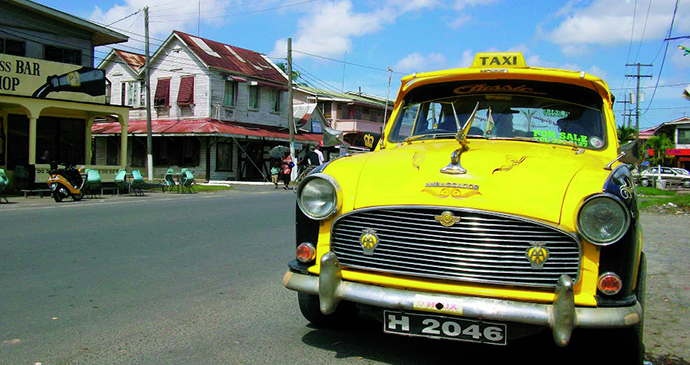
Vehicle hire
It’s possible to hire a vehicle in Guyana, but it’s recommended to leave the driving up to somebody else. Along the coast, and especially in Georgetown, driving conditions are largely anarchic. Many of the roads are in a bad state of repair and when combined with speeding minibuses accidents are frequent. If you do hire a car, remember that traffic drives on the left in Guyana. In the interior, the off-road conditions are best handled by an experienced driver. Many of the areas are remote and if you find yourself stuck or have an accident or car troubles, the nearest help could be kilometres, and hours, away.
To legally drive any vehicle or motorbike in Guyana, you need to have a local licence. Visitors can apply for and receive a local driving permit at Cheddi Jagan International Airport or at the Licence Revenue Office at 200–1 Camp Street, Georgetown; you will need to bring a valid driver’s licence from home. Permits cost US$10 and are valid for a month. Police roadblocks are common and if you are found driving without a licence it will likely entail paying an on-the-spot fee (read: bribe) or dealing with a fine and court date.
Bicycle hire
Besides the chaotic transportation, bicycles are a great way to get around Georgetown. Unfortunately, at the time of writing no companies hired them. In the interior, Rock View Lodge and Bina Hill rent bicycles, as does New Kanuku Bar in Lethem. Arrowpoint Resort also has mountain bikes available for use on their trails. Personal hire is also an option; just ask around.
By taxi
Where there are paved roads in Guyana, there are taxis in plenitude and they are reasonably priced and always easy to hail one, especially now that a new law states they must be painted bright yellow (also look for a licence plate beginning with ‘H’). For longer distances minibuses are always much cheaper, but when a taxi driver is driving too fast, they usually listen when you ask them to slow down. Hiring a taxi can also be a wonderful time to chat about life in Guyana. Most drivers are more than happy to launch into conversations on everything from local politics to overseas relatives.
By bus and minibus
Public buses are not common in Guyana and are normally only used to cover longer distances. A public bus runs between Georgetown and Linden, and while this is slower than taking a minibus, it is often a safer and more comfortable option.
The most common form of public transportation in Guyana is minibus. Locals rely on them because they are cheap, not because they are preferred. In many cases the drivers of the highly personalised vehicles use their vans as a way to express their machismo. They overload their vehicles, have the music entirely too loud, honk with abandon, suck at women and drive recklessly fast. Accidents are all too common on the highways.
For trips of any distance (around Georgetown is usually OK), unless you are on a very tight budget or really want the experience, you should hail a taxi before a minibus. If for any reason you don’t feel safe while travelling in a minibus don’t be afraid to ask the conductor to stop the bus so you can exit. It has saved lives in the past. Minibuses are privately owned but they operate along specific routes and their fares are regulated. Minibus routes will get you almost anywhere in Guyana accessed by roads. In Georgetown, the main bus park, where most buses officially begin and end their route, is scattered around Stabroek Market, mainly in the area of the Croal St Demico House. Routes can be confusing, especially within Georgetown, but almost any local will be able to provide assistance with information on which bus goes where. Minibuses follow no set schedule. For longer trips (Georgetown to Linden, for example) they often won’t leave until the bus is full, hence the reason for the battle over customers at bus parks. At night the number of buses on the road decreases greatly, but visitors should be using a taxi at this time of day for safety. Minibuses are the cheapest (although not the safest) form of transportation. Fares around Georgetown are between US$0.40 and US$1; for destinations throughout the country, fares run up to US$5 (Lethem is US$60–75).
By 4×4
When getting from place to place in the interior, if you’re not using a boat then you’ll likely be in a 4×4 vehicle. There are a few places in Georgetown that rent 4×4 vehicles but this isn’t always recommended unless you are used to the driving conditions and are able to inspect the vehicle to make sure it will withstand interior roads. Many resorts have their own 4×4 vehicles to provide transportation within the interior. It’s not cheap, but the drivers are experienced and know the roads well. Some of the vehicles have seen better days, and seatbelts or even properly closing doors aren’t always in order, but it’s often still the safest option and part of the experience.
Hitchhiking
Hitching in Guyana is not a normal practice. Along the coast where there are paved roads, if you stand at the side of the road with your thumb up, the only vehicles likely to stop are taxis and minibuses. And unless you find yourself completely out of money, you should be able to afford at least the latter. Away from main roads and along the Linden–Lethem road, where traffic is less frequent, it would likely be possible to get a lift from passing vehicles. But relying on hitchhiking, as a way to get from one destination to another, is unreliable and not your safest option.
By river
Outside of the coastal belt, Guyana is a land of many waterways and few well-maintained roadways. As a result, it is nearly impossible to travel around Guyana without using a boat of some sort, be it a large transport ferry or a traditional dugout canoe, a wooden speedboat or a jet boat. During the rainy season when many interior roads disappear under metres of water, boats become even more prevalent. Sometimes using a boat is your only option of getting from point A to point B. The boat rides are essential in more than just practical ways; they also offer some of the best glimpses into daily life in Guyana and are excellent vessels for nature watching.
Choosing when to plan your visit – rainy or dry season – depends on personal preference and desired activities © Dwayne Hackette, Guyana Tourism Authority
When to visit Guyana
Thanks to its proximity to the Equator, there are only two seasons in Guyana: rainy and dry. On the coast, the rainy season occurs from May to mid-July and mid-November to mid-January. The rainy season in Guyana’s interior, however, is different. The heavy rains come from May to August; during these months huge swathes of the savannas flood and rivers can rise some 30ft above their dry season levels. The interior also experiences a shorter period of lighter showers towards the end of December. The ‘cashew rains’, as they are called because they occur during cashew harvesting, last two or three weeks and are often seen as more refreshing than anything else. Most of Guyana is tropical rainforest and so even during the dry season there can be showers, although they are often brief and welcomed, as they cool the soaring temperatures of the dry season. During the rainy season, there are days when not a drop falls, and even on the rainiest of days there are often extended periods of sunshine.
Choosing when to plan your visit – rainy or dry season – depends on personal preference and desired activities. The dry season offers little relief from the heat, while rainy season days are cooler (relatively speaking) but more humid. Also, Guyana is in the tropics and insects should be expected year-round, but the wet season can tend to offer a denser population of beloved creatures such as mosquitoes and kaboura flies.
Travel to and around Guyana’s interior is much easier during the dry season as the rains can render many roads (including the main unpaved road that runs from Linden to Lethem) impassable without the most reliable 4×4 vehicle. On the other hand, the rainy season in the interior means much more travel by boat, which can make for a peaceful, personal way of exploring the interior, especially when you find yourself nearly level with treetops full of birds and monkeys.
Guyana is still a relatively untapped destination for tourists (while there is a tourist trail of sorts that runs through Guyana, it is still a long way from the well trodden path running through much of South America) but visitor arrivals are increasing. The busiest months for travel to the interior of Guyana are September to November and January to April. However, at any time you may find yourself the only visitor staying at an interior lodge. Currently, most of the traffic that goes through the international airport is either part of Guyana’s expatriate community or returning Guyanese. The former occurs throughout the year while the latter experiences surges over the Christmas holidays and during summer breaks, during July and August. Airline tickets to and from Guyana during these times can sometimes drop in availability and rise in costs.
Climate
The climate in Guyana is equatorial, meaning hot all year round, with an average temperature of 27.5˚C and an average annual rainfall of 91ins. Humidity is generally high all year round but is noticeably more uncomfortable during the rainy seasons when saturation levels are often above 90%. There are, however, distinct climatic differences between the coastal belt and the interior. The coast is cooled by sea breezes and has a temperature range of 18–34˚C. The wet season is from mid-November to mid-January and then May to mid-July.
Festivals, events and public holidays
Kashif & Shanghai Football Tournament
This is a annual event which kicks off in the peak of the Christmas season. As such it presents one of our cornerstones for the development of sports tourism. It dates back to 1989 when the first tournament was played – exclusively with teams from Linden. During the 90s the tournaments grew into a national and later even an international event with an increasing number of foreign teams participating.
Mashramani
Mashramani, often abbreviated to Mash, is an annual festival that celebrates Guyana becoming a republic in 1970. The festival, usually held on 23 February – Guyanese Republic Day – includes a parade, music, games and cooking and is intended to commemorate the ‘Birth of the Republic’. Georgetown is definitely the place to be during this festive time, and hotels can book up early.
Holi/Phagwa
The Hindu festival of Holi or Phagwa, as the Guyanese call it, is celebrated by the singing of special songs called Chowtaals and by the spraying of coloured powder (abrack) and water (abeer). Children take special delight in the festival and submerge any passerby with their colourful water jets called pichkaris. The season of Holi starts a month before with the planting of the Holika, a castor oil plant. This plant is burnt one month later as Holika (the devil), commemorating Prahlad’s legendary devotion to Lord Shiva and also the triumph of good over evil.
Rupununi Rodeo
Rodeo complete with events like wild bull riding, horseracing, wild cow milking, wild horseriding, a female barrel race, steer roping, and (for locals only) cari drinking competitions… both official and unofficial. The evening programme presents festivities in the form of a cultural fair with food, games, music and the lively ‘Fawhaw’ dance, said, to have its origin in the popular Northeast Brazilian ‘Forró’ dance. The Rupununi rodeo has its origins in the middle of the last century, when vaqueros competed against each other in various skills; it later grew from being a centralised event in St Ignatius before moving to Lethem in 1985.
Indian Arrival Day
On the 5 May the Indian population of Guyana celebrate their history and culture which began on the day when the first group of indentured labourers arrived from India in 1838. The festival includes village celebrations, trade fairs and excellent traditional Indian cuisine.
Emancipation Day
Emancipation Day is a nationwide national holiday in recognition of the abolition of slavery in 1834. Celebrated on 1 August, this commemoration day features an African Festival in National Park. Traditional foods and crafts are on sale throughout the day and in the evening there is a grand event in the stadium, with music drama and dance.
Amerindian Heritage Month
September is Amerindian Heritage Month with sporting and culture events across the interior culminating in closing ceremonies in or near Lethem. A ceremonial event or two is typically held at the end of the month in Georgetown, often with the President and/or Prime Minister in attendance. Local events at Annai, adjacent to Rock View Lodge, are the most accessible to outside visitors. While Amerindian communities warmly welcome visitors to Heritage events, foreigners rarely know about them so few outsiders ever get to see this annual celebration of Guyana’s indigenous tradition.
Rockstone Fish Festival
The annual Rockstone Fish festival takes place at the community of Rockstone, some 18 miles from Linden, in Region Ten (Upper Demerara / Upper Berbice). It is renowned for hosting Guyana’s largest fish festival aimed at both tourists and locals alike. A two-hour trip will allows participants to experience camping , fishing, birdwatching, or simply exploring the Essequibo River.
What to see and do in Guyana
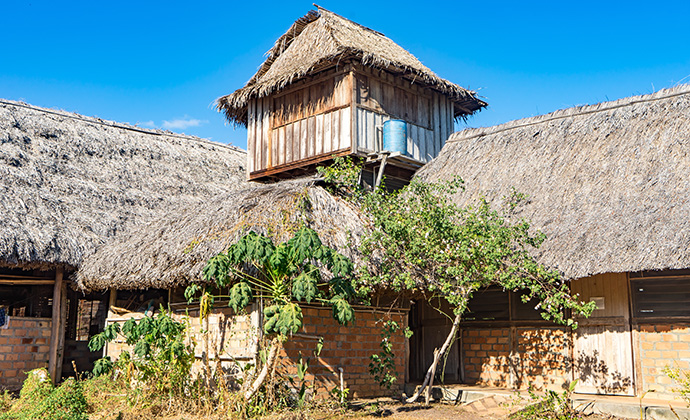
Caiman House Field Station
Caiman House was built in 2005 in Yupukari by Americans Peter Taylor and Alice Layton, who came so Peter – a keeper and supervisor at the Bronx and St. Louis zoos for nearly 20 years – could conduct an ongoing field study on black caiman (Melanosuchus niger), the largest member of the alligator family and a species that is listed by CITES as Appendix I: endangered. Black caiman are severely depleted in nearly all their former range, but are found in abundance in the waters of the Rupununi River.
The ongoing field study, which is now entirely run by community members, is an attempt to gain an understanding of the black caiman’s ecological role, as well as its context within local communities. By basing the study in a local village, and using local residents to run it, it will hopefully instil a better understanding of the caiman’s importance in the local ecosystem. The study itself, and the healthy population of caiman it is finding, has generated a sustainable ecotourism business for the community.
The black caiman research is what will draw most visitors to the region. Guests are invited to join the caiman research crew in a night of caiman capturing. It’s a bit like having a job with a National Geographic crew. There are also other important projects such as a turtle-rearing programme and a jaguar camera-trapping survey that attract both researchers and visitors to the field station and provide important data about these species.
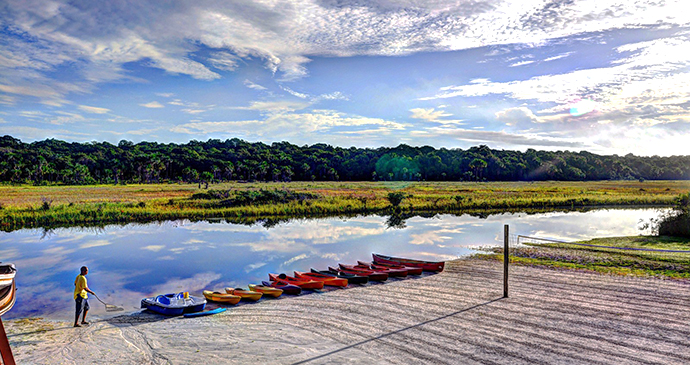
Arrowpoint Nature Resort/Santa Mission
Located within the Santa Mission and on the banks of the Kamuni Creek, this eco-friendly nature resort has plenty of activity options and a tightly structured schedule to make sure guests can sample them all. The resort itself, with four self-contained cabins and one large central building, is designed and operated as an expression of Amerindian culture. While the mountain biking, surf biking and pedal boating may not be reflections of Amerindian culture, the cassava bread making, wabani expedition, canoeing, spear fishing and jungle hikes are more reflective of their traditional lifestyle.
Arrowpoint, which is named after the many arrow trees in the area that are used by Amerindians in the construction of arrows, is a good mixture of the traditional and the modern, of the relaxing and the scheduled. Close to Georgetown, it’s a good location for a day or one-night trip to enjoy a bit of nature without leaving many of the creature comforts behind.
All day trips to Arrowpoint are inclusive of all road and river transportation from Georgetown, lunch, activities and guides; overnight rates include all meals and limited local bar; alcoholic drinks and some soft drinks are extra. The all-inclusive packages, and plethora of activities offered by the resort, unfortunately make Arrowpoint one of Guyana’s more expensive resorts. Discounts are often offered for larger groups.
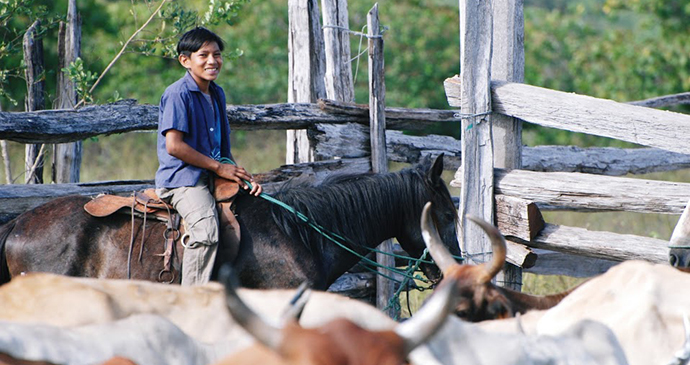
Dadanawa Ranch
Dadanawa has a long and rich history in Guyana. At one point in time Dadanawa held the claim of being the world’s largest cattle ranch; fast forward a bit and the ranch was used as a home base for the filming of several episodes of Mutual of Omaha’s Wild Kingdom, one of television’s first wildlife shows. Stan Brock, one of the show’s hosts and one-time manager of Dadanawa, captured America’s attention by wrestling giant anacondas in waters where black caiman and piranha lurked, and where jaguars were often spotted along the banks.
Today little has changed; it is a place where the past lives on in the present. There are still some 6,000 cattle that openly roam the 1,700 square miles; Dadanawa still holds the title of being Guyana’s largest cattle ranch. The ranch is also a favourite of wildlife film crews and it has served as a temporary home base for many scientists and researchers over the years. The wrestling of anacondas still happens from time to time as well.
Dadanawa is first and foremost a working ranch. Barefoot vaqueros frequently head out on cattle drives to round up steers and wild horses. Talk often lands on the problem with cattle rustlers coming in from the south. Vaqueros must also protect the cattle from jaguars and puma known to poach from the herd.
Sounds of a working ranch fill the air – sheep baa, kids laugh, roosters crow, motorcycles rev, pigs snort, frustrated men pound on engines, horses whinny and cattle moo. But then there are also sounds of the tropical forest – macaws screech overhead, small songbirds sing, beetles scream, monkeys scamper in the trees. And it all, somehow, comes together in beautiful harmony.
Dadanawa is a place where visitors can join vaqueros on an overnight ride to round up cattle one day and birdwatch the next, seeing as many as 80 different species in a few hours around the ranch. You can see the age-old process of tanning leathers and watch vaqueros attempt to tame wild horses one afternoon and then leave the next morning for some of Guyana’s most remote terrain, with some of Guyana’s best and most knowledgeable guides to lead you.
At Dadanawa, guests interact with the locals, the family and the history and are always treated as old family friends. Not because that’s part of the routine but just because that’s how life is. Dadanawa is a place rich in textures, from the people and lifestyles to the weathered woods and worn vehicles, and guests are invited to a place where time seems to have stood still, while still gracefully moving forward. An oxymoron surely, but it should be welcome in today’s modern world.
Georgetown
In the world of tourism, Georgetown could be considered a tough sell. Guyana’s slightly rundown capital city of 240,000 people (350,000 with surrounding towns/villages) was once touted as the ‘Garden City of the Caribbean’, but that name has been fading since the British pulled up their imperialistic stakes (and maintenance money) in the 1960s.
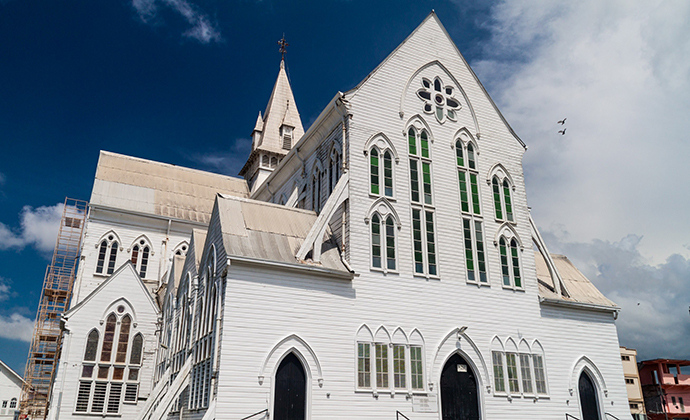
Even though there are more than 200 species of bird found within the capital and still enough green patches, flowering plants and fruit bearing trees to make the most sceptical see the origins of the city’s nickname, when Georgetown appears in Guyana’s tourism guides and brochures amongst conglomerations of nature shots and worn-out adjectives flaunting this ‘Paradise for Nature Lovers’, the city does not come off as quite so appealing.
But why make travel plans based on old epithets? Or visit cities for nature? Guyana’s interior is the draw for most visitors and Georgetown is the gateway, a final dose of hurried civilisation before the vast emptiness of the jungle and savanna.
British and Dutch heritage and a melting pot of lively English-speaking locals make the city decidedly more Caribbean than Latin. Fairytale-like crumbling colonial buildings, both lovingly restored and barely standing, dominate the town’s architecture. Churches stand next to Hindu temples and mosques. Minibuses share the streets with cows, horse-drawn carts and the speeding cars that are at odds with the laidback pace of life.
And with its thriving markets, a few decent museums, some interesting new restaurants, a nearby winery retreat and even a handful of manatees, Georgetown certainly merits a day or two of your time.
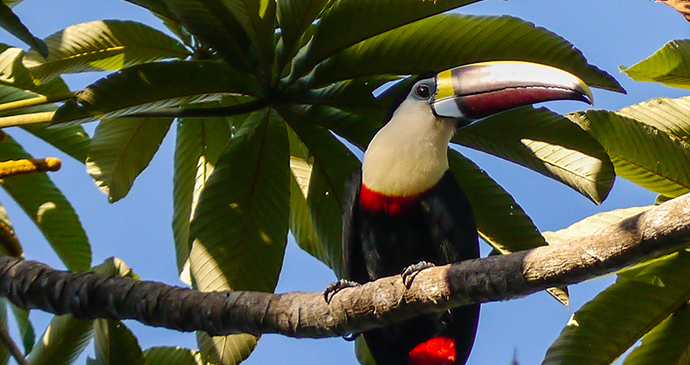
Iwokrama
Located in the heart of Guyana, the Iwokrama Forest has an amazing cross-section of Guyana’s biodiversity, including 1,500 species of flora, 200 mammals, 500 birds, 420 fish and 150 species of reptiles and amphibians. The Government of Guyana and the Commonwealth Secretariat established Iwokrama International Centre for Rainforest Conservation and Development in 1996 under a joint mandate to manage the Iwokrama forest ‘in a manner that will lead to lasting ecological, economic and social benefits to the people of Guyana and to the world in general.’
Since then, Iwokrama has become internationally recognised for its unique and ambitious conservation and development practices that seek to show that rainforest resources can be used sustainably to generate economic benefits for communities through traditional and scientific resource-based knowledge and management.
Iwokrama is home to some of the Americas’ and world’s largest species – black caiman (alligator), capybara (rodent), arapaima (freshwater fish), anaconda (snake), giant anteater, giant river otter, giant river turtle (freshwater turtle), bushmaster (pit viper), false vampire bat (South America’s largest bat), harpy eagle (the Americas’ largest eagle) and jaguar (largest cat in the Western Hemisphere). Of course all these species are living in some very dense forest and can be hard to spot, but there are a number of good activities to increase visitors’ chances.
Any visit should include a walk on some of the nature trails, a night-time boat ride to spot caiman and other nocturnal wildlife, a trip up the 1,000ft-high Turtle Mountain and a boat ride to Kurupukari Falls to see ancient petroglyphs. Lodging at the beautiful River Lodge goes without saying, but the more adventurous should spend at least one night at one of the hammock camps.
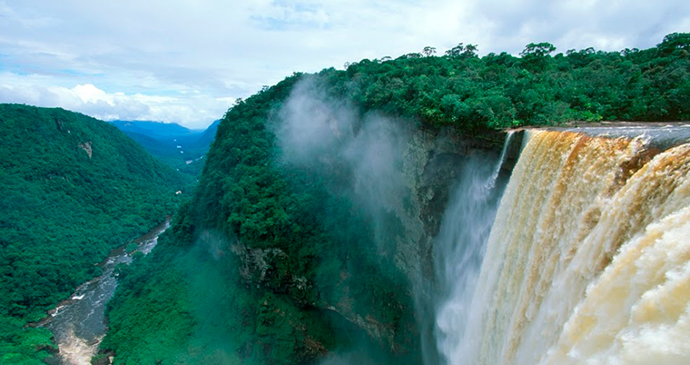
Kaieteur Falls
Within Kaieteur National Park is Guyana’s most celebrated, and highly touted, natural wonder: Kaieteur Falls. Since it was discovered in 1870 by the European explorer, Barrington Browne, Kaieteur Falls has been recognised as the crown jewel of Guyana’s vast ecosystem. During its peak, some 30,000 gallons of water cascade over a 741ft-sheer drop, making Kaieteur Falls one of the world’s largest and most powerful single-drop waterfalls (the falls measure 822ft to the bottom of the gorge; five-times the size of Niagara Falls). In 1929, the British Colonial Administration designated 45 square miles surrounding the falls as a National Park. It was a groundbreaking step for conservation, as it was one of the first such acts in Latin America and the Caribbean. In the 1970s, all glory was lost when the park was downsized to allow for expanded mining concessions in the area. Two decades later, in what must surely have been an embarrassing moment of retrospection for those involved, the boundaries of the park were expanded again to protect it from the damaging mining practices. The good news is that Kaieteur Park now consists of 224 square miles (580km²) of protected lands; unfortunately it remains Guyana’s only national park.
Legend has it that the waterfall draws its name from a selfless Patamona Amerindian chief named Kai. In an effort to appease the Great Spirit Makonaima, Kai sacrificed himself to save his tribe from the vengeful Caribs. Appeasing gods takes bold acts and Kai outdid himself by paddling over the point where the Potaro River tumbles into the gorge below. If nothing else, he succeeded in getting a natural wonder named after him (teur means ‘falls’ in a local dialect).
The beauty of Kaieteur Falls lies in its sheer size and power – during the rainy season, watching 30,000 gallons of water per second flow over the nearly 400ft-wide edge is a stunning sight and sound – but also in its raw state. The isolated location of the falls has kept much development at bay. There are no guard rails, let alone kitschy tourist shops (or any tourists really). Nature, by and large, is left undisturbed and the place surely looks remarkably similar to the day it was ‘discovered’ by Mr Brown.
Karanambu Lodge
Karanambu is one of Guyana’s true tourism highlights. It’s a place steeped in local history, extremely rich in nature and very much in tune with the local surroundings. In more recent years it has become widely known for owner Diane McTurk’s work rehabilitating wild, orphaned giant river otters. Her unique passion has caught the attention of many film crews, including those from the BBC and National Geographic, and provides an interesting backdrop to any visit to Karanambu. Actually, it was a need to fund Diane’s ever-expanding work that gave rise to Karanambu Lodge being opened as an eco-tourism destination. However what was once the driving force and backbone of tourism at Karanambu is now only a fraction of the whole, as Karanambu’s sights have expanded.
In 1997, the Karanambu Trust was formed and a private Protected Area was established for the conservation and protection of Karanambu’s 324km2 of unique habitats, and endless flora and fauna. Over the years, Diane McTurk tirelessly rehabilitated more than 40 giant river otters, or ‘water dogs’ as they are known in Guyana, which attracted many film-makers, journalists and visitors to her lodge. Sadly, she passed away in 2016 at the age of 84 but her family continue to manage the lodge and carry on the great work that she did as a conservationist and pioneer of ecotourism in the Rupununi. To celebrate her remarkable life, in December 2016, the Tourism and Hospitality Association of Guyana, the Guyana Tourism Authority, the National Trust and the Ministry of Indigenous People’s Affairs created the Diane McTurk Scholarship for a student from the hinterland to attend the University of Guyana to obtain a degree in tourism and environmental studies.
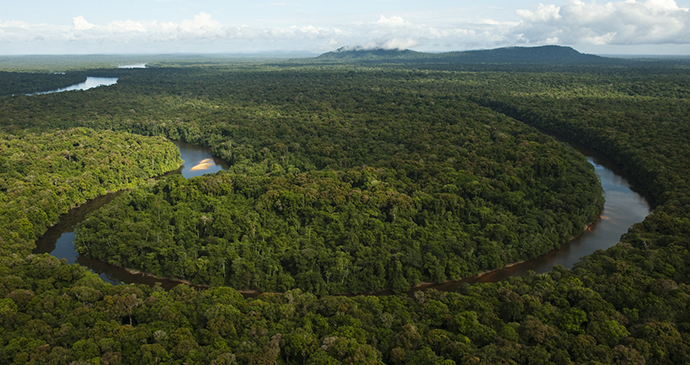
Lower Essequibo River
From its humble source in the Acarai Mountains along Guyana’s southern border with Brazil, the Essequibo River flows north for more than 600 miles – winding, twisting and roaring through savannas and tropical forests along the way – until its mouth opens up some 20 miles (32km) in width and it spills into the Atlantic Ocean. During its journey, the Essequibo, which is Guyana’s largest river, and South America’s third-largest (behind the Amazon and Orinoco), flows aroundsome 365 different islands. The three largest – Wakenaam, Leguan and Hog – create a large tongue in the Essequibo’s mouth. Together their girth measures nearly 60 square miles; alone the islands are larger than some of the famed Caribbean countries to the north.
Many of Guyana’s other great rivers flow into the Essequibo, including the Cuyuni, Mazaruni, Potaro, Rupununi and the Siparuni. The Essequibo is a grand, beautifully moody river that transports the brown muddy waters from wide reaches of Guyana. It was the area that attracted Guyana’s first European settlers and its lower section (from its mouth to just past Bartica, some 80km to the south) continues to bustle with activity and is easily accessible for visitors.
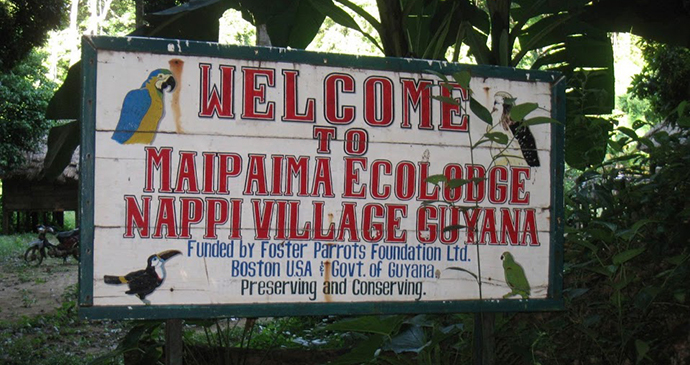
Nappi
Nappi is a small but spread-out Amerindian village in the southern end of the North Rupununi Savannahs, 32km from Lethem. The Makushi village is built along the savannahs that run up against the foothills of the Kanuku Mountains. The surroundings are superb, the villagers are friendly and known throughout Guyana for their intricate balata crafts. Nappi was also known for being the location of Maipaima Eco-Lodge, but it has sadly fallen into disrepair and is not currently operational.
The community of Nappi has long depended on sustenance farming, fishing and hunting for their daily survival. In order to make money, many men leave the village to find work in mining or timber concessions in Guyana, or go to nearby Brazil in search of jobs. With the species-rich Kanuku Mountains at their doorstep, many villagers also depended on the (often illegal) wildlife trade as a source of income.
The expert huntsmen used their skills to capture a range of mammals and birds; the amount they sold them for was a tiny fraction of what the animals would receive at their destinations in North America, Europe or elsewhere. The wildlife trade is an old business in Guyana, but it is also not a sustainable one. Villagers are aware of this and are open to new ways to generate income from their surroundings. With the help of Foster Parrots Ltd, a US-based non-profit parrot rescue, adoption and sanctuary organisation, Nappi looked to ecotourism as an alternative means of income, opening Maipaima Eco-Lodge, with their help. Although the lodge is currently closed, there is hope that there may be more funding available to help get the lodge and Nappi back on the little-trodden tourist trail of this area.
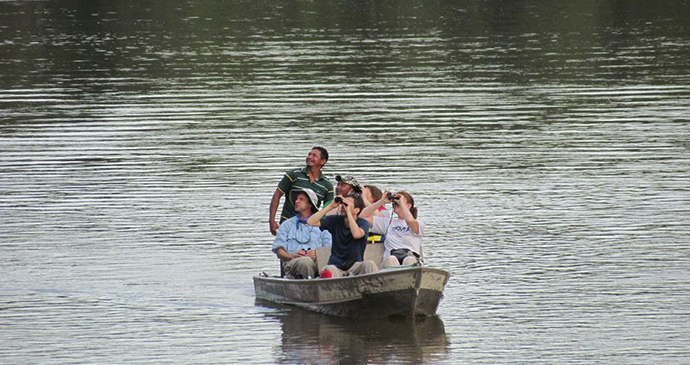
Rewa
Located at the confluence of the Rewa and Rupununi rivers, Rewa village is a small community of roughly 250 inhabitants. It’s more isolated than other tourism destinations in the north – it’s accessed by a 2- to 5-hour boat ride depending on water levels) or 2½-hour bum-jarring motorcycle ride – but it also has one of the most beautiful settings and equals Surama for a destination for adventurous tourists. The area offers visitors one of the greatest chances of seeing many of Guyana’s great mammals, including jaguar, ocelot, tapir, capybara, brocket deer, giant armadillo, peccaries and seven different monkey species. In the rivers there are healthy populations of giant river otters, black and spectacled caiman and giant river turtles. The primary forest that lines the Rewa’s banks also provides for good birdwatching. Sightings of scarlet macaws, tiger herons, bat falcons, kingfishers, great black hawks and several species of parrots and cotingas are common. Harpy eagles are also sometimes seen flying overhead.
Fish life in the rivers is also rich. Peacock bass, pacu, piranha, payara and several large species of catfish can be caught with relative ease. In the ox-bow lakes and ponds, of which there are many along the Rewa, there is a relatively healthy population of arapaima, the world’s largest scaled freshwater fish. Besides attracting tourists to the area, the rich biodiversity of the Rewa River has long attracted researchers and organisations intent on helping the village to conserve its natural surroundings. There are currently a couple of conservation projects revolving around giant river turtles and arapaima. Villagers are learning to fish, hunt and log in a sustainable manner. Through ecotourism they see the value in keeping many of their species alive.
Unfortunately the rich diversity of the area is also attracting the attention of companies who seek to make money in different avenues. Oil exploration is ongoing not far from Rewa village and timber concessions are being granted in the surrounding forests. It’s another case of conflicting progress, but for now Rewa, the surrounding wetlands and the forested rivers remain pristine locations for tourism.
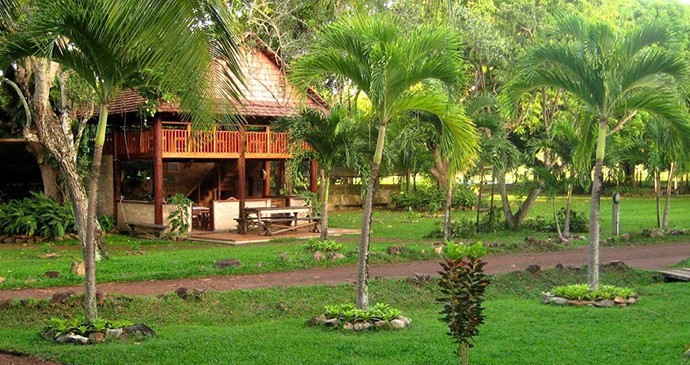
Rock View Lodge
In many ways, Rock View Lodge serves as the main hub for tourism in the North Rupununi. Just over 1km off the main road, Rock View has a central location between Annai and Rupertee villages. The lodge is located on the edge of the savanna, where the Pakaraima Mountain foothills begin to rise to the north. The location is idyllic and the accommodation has been built to match.
The original Rock View ranch house was built in the 1950s with plans to host weary cowboys and ranchers involved in moving cattle from the Rupununi to the coast. In the late 1960s another family took it over and began raising cattle. Rock View went through an early phase of glory when the Dakota flight would land on the nearby airstrip. The Dakota flight came in from the coast to pick up beef, tobacco and peanuts, and people from miles around would gather at the Dakota bar to gossip and talk about political problems that may have helped fuel the Rupununi Uprising in 1969.
In 1992, Colin Edwards, a gregarious Englishman with a vision, bought Rock View in order to fulfil a dream of building an environmentally friendly lodge and working farm that also benefits surrounding communities. Colin started with arid and rundown ranching lands and has created an oasis in the savanna. Gardens flourish, cattle graze freely, flowering and fruit trees abound and numerous jobs have been created for local community members.
Shell Beach
This 145km stretch of beach is the main reason people find themselves planning a trip to this region of Guyana, but visitors don’t just come for the endless expanse of unspoiled Atlantic coastline; they come hoping to see a prehistoric sea turtle crawl ashore and lay her eggs.
Unfortunately, in 2017, the beach was closed to tourism following serious flooding and coastal erosion, and at the time of writing it was unclear when the situation would change. For up-to-date information, go to www.nre.gov.gy for the news from the Protected Areas Commission who look after Shell Beach.
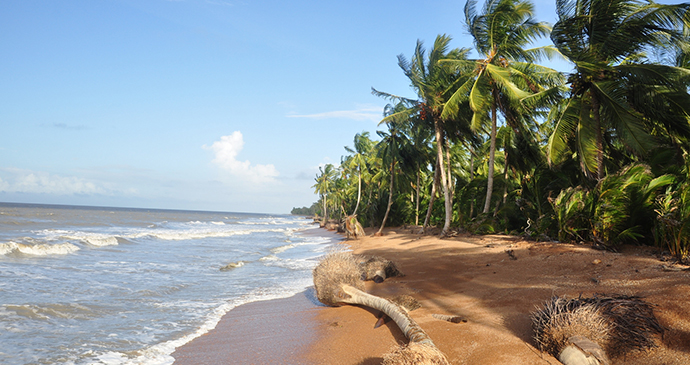
From March through to August, Shell Beach becomes the nesting ground for four of the world’s eight endangered species of marine turtles: leatherback, green, hawksbill and olive ridley. All four species of sea turtles are protected in Guyana by the Protected Areas Act of 2011 and the Fisheries Act 2002. Most of the world’s sea turtle nesting sites are visited by only one or two species, adding to the exceptionality of Shell Beach.
Shell Beach stretches from the mouth of the Waini River, along Guyana’s northwestern sea coast to the Pomeroon River’s mouth, a distance of roughly 145km. It is a rare swathe of undeveloped tropical coastland that, for the most part, remained ecologically undamaged for centuries but now faces several serious threats including flooding, coastal erosion and human activity.
The entire area is broadly referred to as Shell Beach, but nine sections of beach have been given separate names, such as Almond, Kamwatta, Tiger and Gwennie. While largely unpopulated by permanent residents, nearly 150 inhabitants occupy Almond Beach, near the Waini River’s mouth; roughly 180 people reside at Gwennie Beach, near the Pomeroon River.
While the name Shell Beach may sound like a romanticised appellation, it’s actually utilitarian. Shell Beach is a beach composed entirely of seashells, from perfectly intact to crushed bits the size of sand.
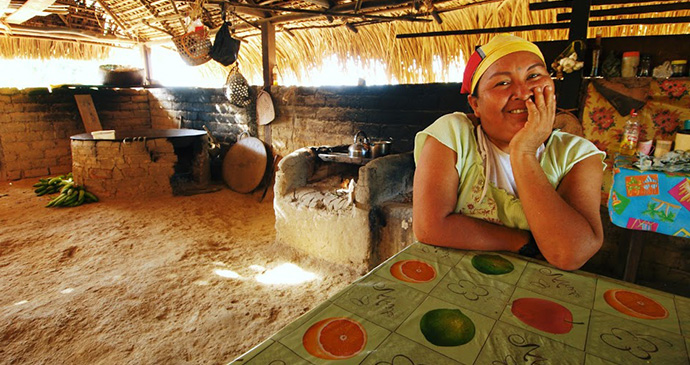
Surama
Surama snapshot: 13km2 of open savannah lands surrounded by the jungle-covered Pakaraima Mountains. A small Amerindian village where the 300-odd Makushi inhabitants rely mainly on farming, hunting and fishing for sustenance and have lifestyles and customs that have changed little in many generations. Most homes are simple buildings of clay brick walls and thatched roofs. Locals manoeuvre through the surrounding jungle with an innate sense of direction that borders on the uncanny. Most trees and plants have a use, be it as a source of fresh water, medicine for snakebites, or food. Howler monkeys often beat roosters in announcing the start of a new day, macaws screech in seeming disapproval, packs of peccaries roam the forest, the river is teeming with piranha, and jaguar have been known to steal into the village at night and kill a horse.
One might expect Surama to be just another ecotourism cliché, little more than local guides offering mountain treks, jungle walks and dugout canoe trips in a remote village where the culture is preserved and they put on a display for the sake of visitors’ dollars. Surama could indeed be called an ecotourism destination; there is even an ecolodge in the village. It’s remote, plus there’s a mountain to climb, jungles to explore and dugout canoes on the river. The word ‘sustainable’ is also a popular way to describe the activities here, but Surama’s charm comes with its own unpretentiousness.
The guides are genuine and their knowledge of the jungle stems from the fact that they rely on it for survival in their daily lives, not because they studied it in a book. The meals are made with local vegetables and meats because that’s what’s available, not because they are trying to fulfil the expectations of foreigners. And the ecotourism possibilities of their village and surroundings were initially explored to create a source of income close to home; too many of the men were leaving in search of jobs at mining or logging camps elsewhere in Guyana and Brazil.
Surama’s location just south of the Iwokrama International Centre for Rainforest Conservation and Development (they share a border along the Burro Burro River) and north of Rock View Lodge helped to initially attract visitors to the village. Today Surama has become the award-winning role model for community-based ecotourism in Guyana; all other villages building a tourism product look to Surama as their guide.
Related books
Related articles
The most memorable stays in Guyana are at community-run lodges that support local people and the environment – here are seven to add to your list.
